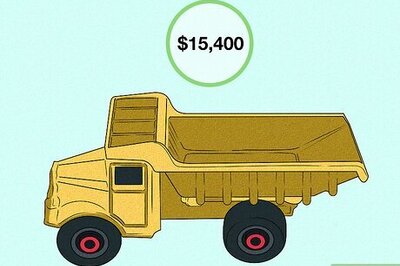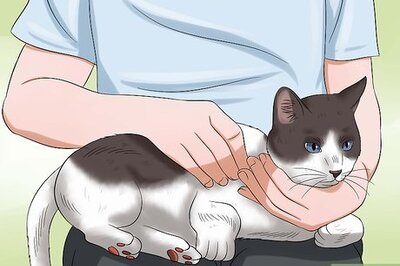
views
What is a Hush Cut?
A Hush Cut is a heavily layered hairstyle that keeps length. Also called “sad girl hair,” this haircut almost always has wispy bangs or face-framing layers. The cut’s movement and light appearance come from subtle layers throughout the length of the hair. This movement also means there’s less styling time for you. The cut is great for people with long hair who want to keep their length but also like experimenting with new styles and fringe. However, the Hush Cut can be worn at any length as long as it has floaty layers and movement. The Hush Cut trend started in South Korea but quickly spread to the US and UK, with many celebrities like Billie Eilish, Rihanna, Florence Pugh, and Jenna Ortega sporting the look.
What to Tell Your Stylist
Ask for a Hush Cut with subtle, face-framing layers and wispy bangs. If you have long hair, say you want long layers that start around the chin and blend into the rest of your hair. Then, tell them you want a low-maintenance style that gives you movement and enhances your hair’s natural texture. If your hair is medium length, ask for layers that start at your cheekbone. For shorter styles, like pixies and bobs, ask for shorter layers around the crown of your head. Your stylist may not be familiar with the name of the cut, even if they have seen pictures and understand how to cut it, so make sure you describe exactly what you want.
Bring pictures of styles you like to show your stylist. Describing a haircut to your stylist can be tricky. Bringing in photos of styles you like gives you a starting reference so you’re both on the same page. Then, tell them what you like and don’t like about the cut in the image. Try to find pictures of people with hair textures and colors similar to yours. This helps your stylist visualize the style on your hair. Pay attention to your stylist’s recommendations. They can help you adapt the style to best suit your hair type and face shape to get the look you want.
Styling & Maintaining a Hush Cut
Get your Hush Cut trimmed every 8-10 weeks. One of the great things about the Hush Cut is that it’s low maintenance. The long layers are very forgiving and only need a trim every 8-10 weeks to keep your style looking good. This helps to maintain the shape and get rid of any split ends. Short Hush Cuts may need more frequent trims. Get trims every 4 weeks if you want to maintain the shape and length. Stretch it out to every 6 weeks if you’re growing out the length.
Use volumizing products like hair mousse and texturizing sprays. The best part about this style is that it doesn’t require a lot of styling time. For a messier look, use a texturizing spray or an air-dry cream and let your hair dry naturally. Run a baseball-sized puff of hair mousse through your hair with your fingers and then blow dry your hair for lots of volume. Use texturizing spray by spritzing it into your hands and working it through your dry hair from the mid-lengths down to the end to add volume and texture. For damp hair, rub a dime-sized amount of air-dry cream between your palms. Then rake it through your hair from root to tip and allow it to air dry to embrace your natural texture.
Blow dry your Hush Cut with a round brush for volume. For maximum volume, blow dry your hair using a round brush with a 1.5-inch (3.81 cm) barrel. Start by spraying a heat protectant product on damp hair. Then, run a comb through your hair to distribute the product evenly. Separate your hair into sections. Blow dry each section using your round brush to smooth your hair and give it a slight bend. Once all your hair is dry, spritz it with a texturizing spray to define your layers.
Who should get a Hush Cut?
Hush Cuts flatter most face shapes. One of the main benefits of a Hush Cut is that the feathery layers are very flattering to a wide range of facial contours. Plus, the soft ends keep the cut from feeling heavy, which can drag down longer face shapes. Let your stylist know which features to highlight so they can structure the layers for your desired look. Oval: Hush Cuts should frame your cheekbones and have bangs that aren’t too long or too short to maintain your face’s natural balance. Round: Round face shapes look great with a shoulder-length Hush Cut with layers that draw attention to your eyes and cheekbones. Square: The layers and wispy bangs of a Hush Cut help soften the symmetrical lines and angular bone structure of square face shapes. Heart: Like the Round face shape, a shoulder-length Hush Cut looks best on people with Heart-shaped faces. However, curtain bangs better balance your wider cheekbones and pointed chin. Long: People with Long face shapes look best with soft layers and bangs that widen your cheekbones. Keep bangs light, airy, and on the shorter side to avoid further elongating your features.
Hush Cuts work with most hair types with a few tweaks. While the ideal hair texture is straight or wavy hair that’s medium or thick in density, finer hair looks great with cuts featuring fewer layers. Hush Cust on the thicker hair look better with more exaggerated layers to keep the style light. Ask for longer layers if your hair is wavy or curly. Your hair naturally shrinks a bit as it dries. This cut is also a great style if you’re growing out a Wolf Cut or Shag because it’s easy to soften the structure of those cuts into the Hush Cut.
Different Types of Hush Cuts
Bixie Hush Cut A Bixie is a combination of a Bob and a Pixie hairstyle that is often achieved by letting your pixie cut grow out. To give the Bixie a Hush Cut makeover, ask for shorter layers around the crown for lift. Style Tip: Style it with a texturizing spray and your hands to give it a fun, piece-y look.
Flipped-Out Lob Hush Cut This Lob Hush Cut is cut to shoulder length or slightly longer. The bangs are a little heavier than the wispy bangs of a true Hush Cut and parted in the middle. This gives the style a more modern, edgier look. Style Tip: Blow dry the face-framing layers out by sectioning them off and brushing them up and back. Then, let them fall around your face.
Mid-Length Mullet Hush Cut This cut brushes the top of your shoulders with a full top, airy bottom, and wispy bangs. It gets its name because of how closely the back hangs to your neck. However, this cut is softer than a traditional mullet, with delicate face-framing layers. Style Tip: Style it messy by air drying for an edgier look. Or, smooth your layers with a blow dryer and round brush for a softer, more classic look.
Straight Hush Cut with Short Bangs Stylists cut the hair shorter from the ears forward to frame your face. The back is left longer and layered for movement. Blow dry by raking your hands through your hair to get a shaggy, texturized look. Style Tip: Use a texturizing spray on your dry hair for an extra boost of texture.
Feathery Hush Cut This cut has long layers with a curtain-style fringe and feathery ends. It’s similar to a classic Hush Cut but with lighter ends and curtain bangs for a retro 1970s look. Style Tip: To style it, apply an egg-sized puff of hair mousse from the roots to the ends of your hair. Then, blow dry your hair with a round brush for a romantic, feathery look.
Hush Cut vs. Wolf Cut vs. Shag
The Hush Cut tends to have longer layers than the Shag and Wolf Cut. The Hush Cut can be adapted to any length and has wispy bangs, curtain bangs, or no bangs at all. The overall effect is meant to be romantic and effortless. Wolf Cut: This cut is choppy and structured, while the Hush Cut is wispy and light. The Wolf Cut’s layers are shorter and disconnected with shorter fringe. Shag: The Shag has some similarities with the Hush Cut, but it’s more relaxed and textured, while the Hush Cut is more subtle and natural looking. The Shag is also characterized by a longer fringe with an overall short-to-medium length.




















Comments
0 comment